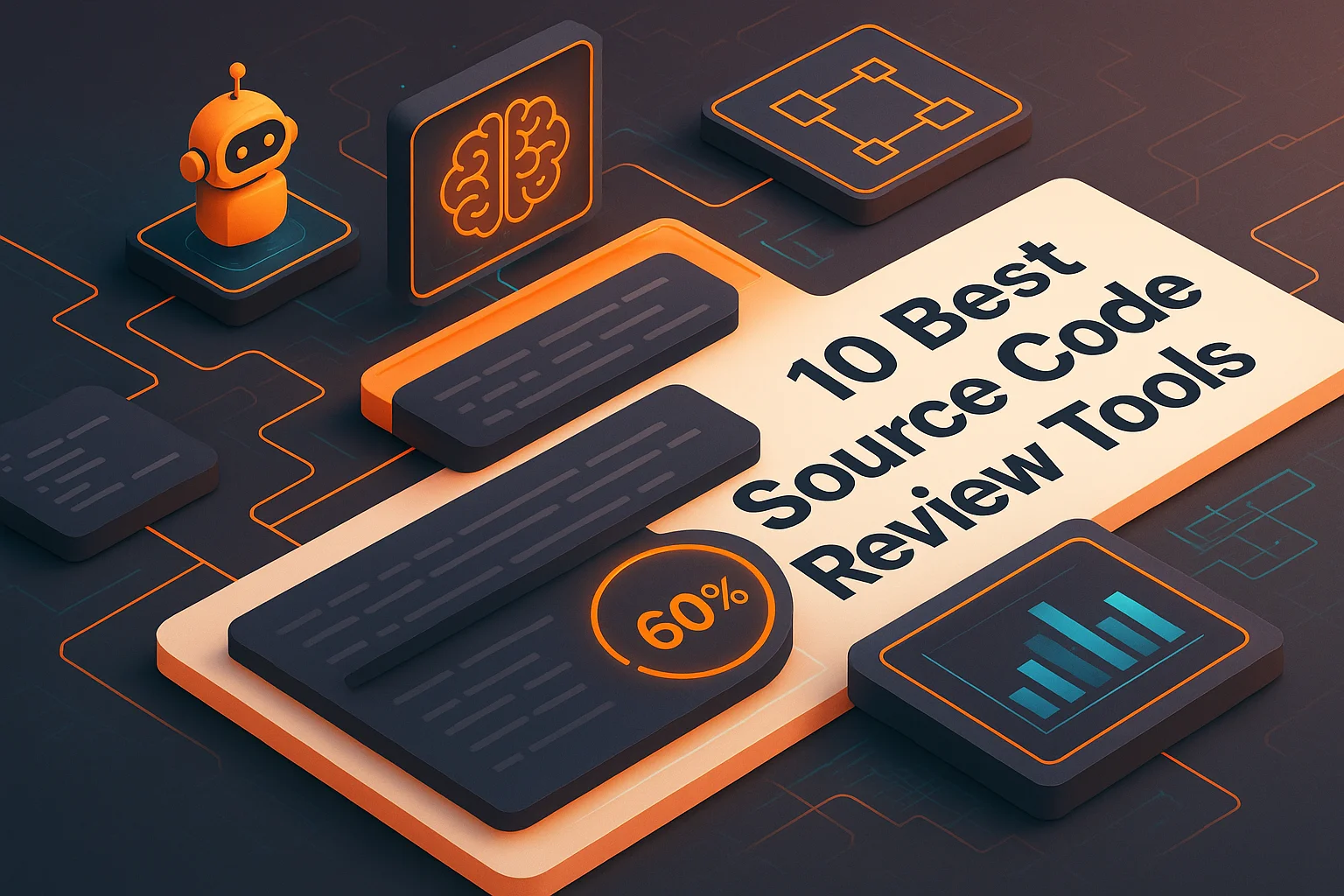7 Code Analyzer Tools That Catch 95% More Bugs (2025 Guide)

Building great software isn't just about writing functional code; it's about crafting a maintainable, scalable, and secure codebase that can stand the test of time. Code analyzer tools play a vital role in this process, acting as automated guardians of code quality. They meticulously scan your code for potential issues, from simple style inconsistencies to complex security vulnerabilities, helping your team ship better software, faster.
Key Takeaways
- Code analyzers are crucial for building better software: These tools help catch bugs early, strengthen security, and speed up development, allowing teams to ship high-quality software efficiently. Integrate them into your workflow, especially your CI/CD pipeline, for maximum impact.
- Finding the right code analyzer for your team is essential: Consider your project's needs, the languages you use, and how well the tool integrates with your current setup. Explore different options to find the best fit, and remember that customizing and regularly updating the tool is key.
- Human expertise is still incredibly important: Automated tools are powerful, but they can't replace skilled developers. Encourage your team to see code analyzers as helpful partners, using their feedback to improve code and learn. Combine automated checks with thoughtful human review for the best results.
What are Code Analyzer Tools?
Code analyzer tools are your automated assistants for improving software quality. They examine your codebase to identify potential issues, from simple style inconsistencies to complex security vulnerabilities. Think of them as tireless reviewers offering consistent feedback, helping your team ship better software, faster.
Definition and Core Functionality
Code analyzers scrutinize your source code for defects and deviations from coding best practices. They automatically flag bugs, security flaws, and style issues early in the development process, saving you valuable time and resources. Many tools integrate seamlessly into existing workflows, such as nightly builds or continuous integration pipelines, providing continuous feedback as you code. Some even offer suggestions for alternative implementations, helping developers learn and improve their coding skills.
Static vs. Dynamic Analysis
Code analyzers primarily use two methods: static analysis and dynamic analysis. Static analysis examines the code without actually running the program. These tools range from simple style checkers to sophisticated systems that can identify potential vulnerabilities like buffer overflows and SQL injection flaws. Dynamic analysis, conversely, involves running the program and observing its behavior in real time. This approach can uncover issues that static analysis might miss, such as memory leaks or performance bottlenecks. Many modern code analyzers combine both static and dynamic techniques for a comprehensive view of your code's health.
Key Features of Modern Code Analyzers
Modern code analyzers are more than just linters; they're sophisticated tools that help engineering teams write better, safer, and more performant code. Here's a breakdown of some key features:
Syntax and Style Checking
Maintaining a consistent coding style across your codebase is crucial for readability and maintainability. Syntax and style checkers, like those found in tools such as ESLint, automatically enforce coding conventions and flag deviations. This ensures your team adheres to established standards, reducing the cognitive load during code reviews and making onboarding new developers easier. These tools catch simple errors like missing semicolons or incorrect indentation, freeing up developers to focus on more complex logic.
Error Detection and Security Vulnerability Scanning
Beyond style, modern code analyzers excel at detecting potential errors and security vulnerabilities. They can identify common issues like null pointer exceptions, resource leaks, and potential race conditions. More advanced tools can even scan for security vulnerabilities, such as SQL injection and cross-site scripting (XSS) flaws, helping you proactively address security risks. This early detection is invaluable for preventing bugs from making their way into production, saving you time and resources down the line.
Performance Optimization
Performance is paramount in today's software landscape. Code analyzers can identify performance bottlenecks, such as inefficient algorithms or excessive memory usage. They can suggest optimizations, helping you write more efficient code that consumes fewer resources and delivers a better user experience. This focus on performance optimization contributes to easier code maintenance and a more robust application overall.
AI-Assisted Analysis
The latest advancements in code analysis leverage the power of AI and machine learning. These AI-powered tools can provide more context-aware feedback, going beyond simple syntax checks to offer insights into code logic, potential design flaws, and even suggest alternative implementations. While integrating AI-driven code reviews can be complex, the potential benefits are significant, including improved code quality and faster review cycles.
Benefits of Using Code Analyzers
For engineering teams, code analyzers are more than just helpful tools; they're essential for building high-quality software efficiently. Let's explore the key advantages of integrating these tools into your workflow.
Detect Bugs Early and Improve Code Quality
Think of code analyzers as automated code reviewers that catch issues early in the development process. Static analysis tools, in particular, examine your code without executing it, identifying potential bugs, style inconsistencies, and even security vulnerabilities before they become costly problems. Finding and fixing these issues early in the development lifecycle is significantly more efficient than addressing them later during testing or, even worse, after release.
Enhance Security
Security vulnerabilities are a major concern for any software development team. Code analyzers play a crucial role in identifying potential security risks by scanning your code for known vulnerabilities like SQL injection flaws and buffer overflows. These tools, often referred to as SAST tools, pinpoint these weaknesses in your codebase, allowing developers to address them quickly and effectively. This proactive security approach minimizes the risk of breaches and protects your application from potential exploits.
Accelerate Development Cycles
By automating many of the tedious tasks associated with code quality checks, code analyzers free up developers to focus on more complex and strategic work. Instead of spending time on manual reviews and repetitive checks, your team can concentrate on building features and solving challenging problems. This streamlined workflow accelerates development cycles and allows you to ship high-quality software faster.
Automate Code Quality Checks
Integrating code analysis tools into your CI/CD pipeline automates the process of code quality assurance. Tools like SonarQube provide real-time feedback as developers write code, ensuring that quality checks are performed continuously throughout the development process. This automation not only saves time but also enforces coding standards and best practices across your entire team, leading to a more consistent and reliable codebase.
Popular Code Analyzers and Their Features
Picking the right code analyzer depends on your team's specific needs and tech stack. To help you get started, let's look at four popular options and their strengths.
SonarQube
SonarQube is a versatile platform for static code analysis, supporting many programming languages like Java, Python, JavaScript, and C++. Its flexibility shines through its various uses: on-demand scans, continuous integration, and integrations with popular development environments. This makes it a solid option for teams looking for a comprehensive code quality tool. It's particularly helpful for identifying bugs, vulnerabilities, and code smells, ultimately helping improve code maintainability and reliability.
ESLint
If your team primarily works with JavaScript, ESLint is a highly configurable static analysis tool worth exploring. Its strength lies in its customizability—developers can define specific linting rules tailored to their project's coding style and best practices. This level of control makes ESLint a popular choice for maintaining consistent code quality across JavaScript projects, ensuring adherence to internal standards and catching potential issues early on.
Checkmarx
For teams prioritizing security, Checkmarx offers a robust static application security testing (SAST) solution. It excels at identifying security vulnerabilities early in the development lifecycle, allowing developers to address potential risks before they reach production. By integrating Checkmarx into your workflow, you can proactively mitigate security threats and ensure your applications are built on a solid foundation.
Codacy
Codacy stands out as a code quality monitoring tool that automates code reviews and offers valuable insights into your codebase. Its seamless integration with various CI/CD pipelines and support for multiple programming languages makes it adaptable to diverse development environments. Codacy helps streamline code review processes and provides actionable feedback to improve code quality continuously.
Integrate Code Analyzers into Your Workflow
Integrating code analyzers effectively is key to maximizing their benefits. Think of these tools not as isolated checks, but as integral components of your development lifecycle. Here's how to seamlessly weave them into your workflow:
Continuous Integration and Deployment
Code analysis tools shine in CI/CD pipelines. Set up automatic scans with every code update to catch issues early. This proactive approach prevents small problems from snowballing into major headaches down the line. Imagine your CI/CD pipeline as a quality control checkpoint, ensuring that every code change meets your standards before it goes live. This continuous feedback loop helps maintain code quality and reduces the risk of introducing bugs into production.
Code Review Processes
Code reviews are essential, but they can be time-consuming. Integrating code analyzers lightens the load by automatically flagging potential issues. This allows your team to focus on higher-level aspects of the code, like design and architecture, during reviews. Think of it as having an extra set of eyes, constantly scanning for common errors and vulnerabilities. This not only improves the quality of your code but also makes code reviews more efficient.
Developer Onboarding and Training
Introducing new tools can sometimes be met with resistance. Make the transition smoother by providing comprehensive training on your chosen code analyzer. Don't just show developers how to use the tool; explain why it's beneficial. Highlight how it improves code quality, reduces technical debt, and ultimately makes their lives easier. When developers understand the value of these tools, they're more likely to embrace them.
Best Practices for Effective Code Analysis
Effective code analysis isn't just about picking the right tool—it's about implementing it strategically. These best practices will help you maximize the impact of your code analyzer and foster a culture of quality within your engineering team.
Define Custom Rules and Standards
Generic rulesets are a good starting point, but truly effective code analysis requires customization. Take the time to define coding standards specific to your organization's needs and project requirements. This ensures the analyzer flags issues relevant to your codebase and architecture. Clearly communicating these standards to your team is crucial for smooth adoption and consistent enforcement.
Update and Maintain Tools Regularly
Code analysis tools, like any software, require regular updates and maintenance. Staying up-to-date ensures you're leveraging the latest features, performance improvements, and security patches. Regularly reviewing your tool's configuration is also essential. As your codebase evolves and best practices change, your analysis tools need to adapt.
Balance Automation and Human Review
While automated code analysis offers significant advantages, it's not a replacement for human expertise. Strive for a balance between automated checks and thoughtful human review. Automated tools excel at catching common errors and enforcing style guidelines, freeing up developers to focus on higher-level design and logic. However, complex issues and nuanced code patterns often require human insight.
Choose the Right Code Analyzer
Selecting the right code analyzer is crucial for maximizing its benefits and ensuring it aligns with your team's workflow. A thoughtful evaluation process will save you time and resources down the line.
Assess Your Project Needs
Before exploring the many code analyzers available, take a step back and assess your project's specific needs. What are your primary goals? Are you focused on improving code quality, enhancing security, or speeding up development cycles? Understanding your objectives will guide your selection process. Consider whether you're working with a complex legacy application or a modern microservices architecture, as this will influence the type of analyzer best suited for your needs.
Evaluate Tool Capabilities and Integrations
Once you understand your project's needs, you can start evaluating the capabilities of different code analyzers. Look for tools that offer the specific features you require, such as syntax checking, error detection, security vulnerability scanning, and performance optimization. Consider the programming languages used in your project and ensure the analyzer supports them. Seamless integration with your existing development workflow is also critical.
Consider Language-Specific Needs
Different programming languages have unique syntax, conventions, and potential vulnerabilities. Consider your project's language-specific needs when choosing a code analyzer. Some analyzers specialize in specific languages, while others offer broader support. Ensure the analyzer you choose has robust support for the languages used in your project.
Overcome Challenges with Code Analyzers
While code analyzers offer significant advantages, they also present challenges. Understanding these hurdles and how to address them is key to maximizing their effectiveness.
Address False Positives and Tool Limitations
One common frustration with code analyzers is the occurrence of false positives. These are instances where the tool flags an issue that isn't actually a problem. Too many false positives can lead to "alert fatigue," where developers start ignoring warnings altogether. To mitigate this, customize your code analyzer's rules to align with your specific project requirements and coding style. Regularly review and refine these rules to minimize unnecessary alerts.
Understand the Role of Human Expertise
Code analyzers are powerful tools, but they shouldn't replace human expertise. Think of them as an assistant, not a substitute, for skilled developers. Human oversight is essential for interpreting the results of code analysis, prioritizing fixes, and addressing complex issues that the tool might miss. Encourage your team to view code analyzers as collaborative partners.
Keep Up with Evolving Technologies
The software development landscape is constantly changing, with new languages, frameworks, and paradigms constantly emerging. To stay effective, your code analysis tools need to keep pace. Ensure your chosen tools are updated regularly to support the latest technologies and address newly discovered vulnerabilities.
The Future of Code Analysis
As software development practices evolve, so too must the tools we use to maintain code quality and security. Code analysis is no exception. The future of code analysis promises even more sophisticated solutions, driven by advancements in AI, broader language support, and a deeper understanding of security.
AI and Machine Learning Advancements
AI and machine learning are poised to revolutionize code analysis. These technologies can analyze massive codebases, identify patterns and anomalies, and even predict potential vulnerabilities with increasing accuracy. Imagine a tool that not only flags a potential buffer overflow but also suggests a secure alternative, explaining its rationale and pulling context from your internal documentation.
Adapting to New Programming Paradigms
The programming landscape is constantly shifting. New languages, frameworks, and paradigms emerge regularly, each with its own set of nuances and potential pitfalls. Code analysis tools must adapt to this ever-changing environment. Future tools will need to go beyond basic syntax checks and delve into the intricacies of each language, offering specialized analysis and guidance tailored to specific programming paradigms.
Multi-Layered Security Approaches
Security remains a paramount concern in software development. No single tool offers a complete solution to all security vulnerabilities. The future of code analysis lies in multi-layered security approaches. This involves integrating various tools and techniques, combining static and dynamic analysis, and incorporating security testing throughout the software development lifecycle.
Frequently Asked Questions
How do I choose the right code analyzer for my team?
Start by clearly defining your team's goals and priorities. Are you primarily focused on improving code quality, enhancing security, or accelerating development cycles? Next, consider your project's specific needs, including the programming languages used, the size and complexity of your codebase, and your existing development workflow. Evaluate the features and integrations offered by different code analyzers, looking for tools that align with your objectives and seamlessly integrate into your current processes.
What's the difference between static and dynamic code analysis?
Static analysis examines your code without actually running it, much like a spellchecker reviews a document. It's great for catching syntax errors, style inconsistencies, and potential vulnerabilities early on. Dynamic analysis, on the other hand, involves running your code and observing its behavior in real time. This helps uncover issues like memory leaks, performance bottlenecks, and runtime errors that static analysis might miss.
How can I integrate code analyzers into our existing workflow without disrupting our development process?
The key is to start small and gradually integrate code analyzers into your existing processes. Begin by incorporating them into your continuous integration/continuous delivery (CI/CD) pipeline. This allows for automated code checks with every commit, catching issues early and preventing them from snowballing into larger problems. Next, integrate the analyzer into your code review process. This helps streamline reviews by automatically flagging potential issues, allowing reviewers to focus on higher-level aspects of the code.
What are some common challenges with code analyzers, and how can I overcome them?
One common challenge is dealing with false positives – instances where the tool flags an issue that isn't actually a problem. Customize your analyzer's rules to align with your project's specific requirements and coding style to minimize false positives. Another challenge is the temptation to rely solely on automated tools. Remember that code analyzers are meant to augment, not replace, human expertise. Encourage your team to view these tools as collaborative partners.
What does the future hold for code analysis?
The future of code analysis is bright, driven by advancements in artificial intelligence (AI) and machine learning. AI-powered analyzers can delve deeper into code, identifying complex patterns, predicting potential vulnerabilities, and even suggesting fixes with greater accuracy. These tools will become increasingly sophisticated, offering more personalized feedback and intelligent assistance to developers.
Ready to Transform Your Code Review Process?
See how Propel's AI-powered code review helps engineering teams ship better code faster with intelligent analysis and actionable feedback.

